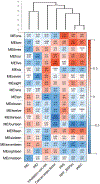Linking Coregulated Gene Modules with Polycyclic Aromatic Hydrocarbon-Related Cancer Risk in the 3D Human Bronchial Epithelium
- PMID: 34048650
- PMCID: PMC8560124
- DOI: 10.1021/acs.chemrestox.0c00333
Linking Coregulated Gene Modules with Polycyclic Aromatic Hydrocarbon-Related Cancer Risk in the 3D Human Bronchial Epithelium
Abstract
Exposure to polycyclic aromatic hydrocarbons (PAHs) often occurs as complex chemical mixtures, which are linked to numerous adverse health outcomes in humans, with cancer as the greatest concern. The cancer risk associated with PAH exposures is commonly evaluated using the relative potency factor (RPF) approach, which estimates PAH mixture carcinogenic potential based on the sum of relative potency estimates of individual PAHs, compared to benzo[a]pyrene (BAP), a reference carcinogen. The present study evaluates molecular mechanisms related to PAH cancer risk through integration of transcriptomic and bioinformatic approaches in a 3D human bronchial epithelial cell model. Genes with significant differential expression from human bronchial epithelium exposed to PAHs were analyzed using a weighted gene coexpression network analysis (WGCNA) two-tiered approach: first to identify gene sets comodulated to RPF and second to link genes to a more comprehensive list of regulatory values, including inhalation-specific risk values. Over 3000 genes associated with processes of cell cycle regulation, inflammation, DNA damage, and cell adhesion processes were found to be comodulated with increasing RPF with pathways for cell cycle S phase and cytoskeleton actin identified as the most significantly enriched biological networks correlated to RPF. In addition, comodulated genes were linked to additional cancer-relevant risk values, including inhalation unit risks, oral cancer slope factors, and cancer hazard classifications from the World Health Organization's International Agency for Research on Cancer (IARC). These gene sets represent potential biomarkers that could be used to evaluate cancer risk associated with PAH mixtures. Among the values tested, RPF values and IARC categorizations shared the most similar responses in positively and negatively correlated gene modules. Together, we demonstrated a novel manner of integrating gene sets with chemical toxicity equivalence estimates through WGCNA to understand potential mechanisms.
Conflict of interest statement
The authors declare they have no competing financial interests.
Figures




Similar articles
-
Utilization of the CometChip assay for detecting PAH-induced DNA bulky adducts in a 3D primary human bronchial epithelial cell model.Toxicology. 2025 Nov;517:154241. doi: 10.1016/j.tox.2025.154241. Epub 2025 Jul 23. Toxicology. 2025. PMID: 40713011 Free PMC article.
-
A rapid and systematic review of the clinical effectiveness and cost-effectiveness of topotecan for ovarian cancer.Health Technol Assess. 2001;5(28):1-110. doi: 10.3310/hta5280. Health Technol Assess. 2001. PMID: 11701100
-
Assessing susceptibility for polycyclic aromatic hydrocarbon toxicity in an in vitro 3D respiratory model for asthma.Front Toxicol. 2024 Apr 19;6:1287863. doi: 10.3389/ftox.2024.1287863. eCollection 2024. Front Toxicol. 2024. PMID: 38706568 Free PMC article.
-
Behavioral interventions to reduce risk for sexual transmission of HIV among men who have sex with men.Cochrane Database Syst Rev. 2008 Jul 16;(3):CD001230. doi: 10.1002/14651858.CD001230.pub2. Cochrane Database Syst Rev. 2008. PMID: 18646068
-
Cost-effectiveness of using prognostic information to select women with breast cancer for adjuvant systemic therapy.Health Technol Assess. 2006 Sep;10(34):iii-iv, ix-xi, 1-204. doi: 10.3310/hta10340. Health Technol Assess. 2006. PMID: 16959170
Cited by
-
Wildfires and extracellular vesicles: Exosomal MicroRNAs as mediators of cross-tissue cardiopulmonary responses to biomass smoke.Environ Int. 2022 Sep;167:107419. doi: 10.1016/j.envint.2022.107419. Epub 2022 Jul 16. Environ Int. 2022. PMID: 35863239 Free PMC article.
-
3' RNA-seq is superior to standard RNA-seq in cases of sparse data but inferior at identifying toxicity pathways in a model organism.Front Bioinform. 2023 Jul 27;3:1234218. doi: 10.3389/fbinf.2023.1234218. eCollection 2023. Front Bioinform. 2023. PMID: 37576716 Free PMC article.
-
Development of the InTelligence And Machine LEarning (TAME) Toolkit for Introductory Data Science, Chemical-Biological Analyses, Predictive Modeling, and Database Mining for Environmental Health Research.Front Toxicol. 2022 Jun 22;4:893924. doi: 10.3389/ftox.2022.893924. eCollection 2022. Front Toxicol. 2022. PMID: 35812168 Free PMC article.
-
Unconventional excited-state dynamics in the concerted benzyl (C7H7) radical self-reaction to anthracene (C14H10).Nat Commun. 2022 Feb 10;13(1):786. doi: 10.1038/s41467-022-28466-7. Nat Commun. 2022. PMID: 35145103 Free PMC article.
-
Placental transcriptomic signatures of prenatal exposure to Hydroxy-Polycyclic aromatic hydrocarbons.Environ Int. 2023 Feb;172:107763. doi: 10.1016/j.envint.2023.107763. Epub 2023 Jan 18. Environ Int. 2023. PMID: 36689866 Free PMC article.
References
-
- Bojes HK & Pope PG Characterization of EPA’s 16 priority pollutant polycyclic aromatic hydrocarbons (PAHs) in tank bottom solids and associated contaminated soils at oil exploration and production sites in Texas. Regulatory Toxicology and Pharmacology 47, 288–295, doi:10.1016/j.yrtph.2006.11.007 (2007). - DOI - PubMed
-
- Witt G & Siegel H The Consequences of the Oder Flood in 1997 on the Distribution of Polycyclic Aromatic Hydrocarbons (PAHs) in the Oder River Estuary. Marine Pollution Bulletin 40, 1124–1131, doi:10.1016/S0025-326X(00)00066-7 (2000). - DOI
-
- Witter B, Winkler M & Friese K Depth Distribution of Chlorinated and Polycyclic Aromatic Hydrocarbons in Floodplain Soils of the River. Acta hydrochimica et hydrobiologica 31, 411–422, doi:10.1002/aheh.200300501 (2003). - DOI
Publication types
MeSH terms
Substances
Grants and funding
LinkOut - more resources
Full Text Sources
Other Literature Sources
Medical

